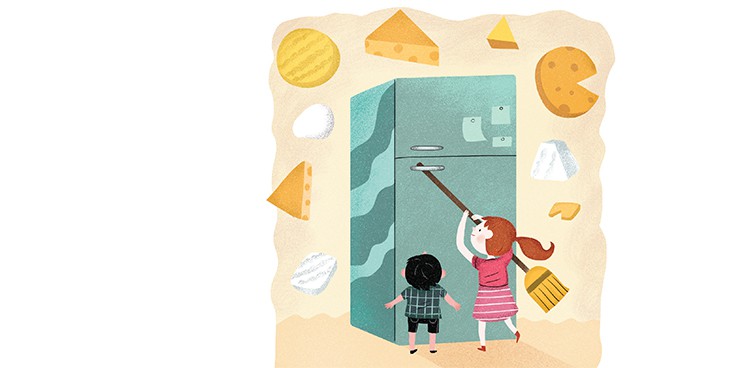
My mother locked our fridge. It was a simple hook-and-eye latch meant to keep out my brother but could be popped open easily by a strategically placed broomstick—or by an enterprising older sister.
I’m that older sister.
My brother Andrew is allergic to dairy proteins, a tough sentence for a guy whose favorite food is cheese. (He recently told me if he were on death row, he’d request lobster ravioli and a log of provolone for his last meal.)
As a ruddy-faced toddler, Andrew could frequently be found elbow-deep in the cheese drawer, stuffing grated mozzarella, Mexican-blend shreds, waxy Kraft singles—whatever suburban supermarket variety was on sale that week—into his mouth by the handful. Once, it was a full stick of butter. The fridge bolt came soon after.
Andrew was diagnosed with the allergy, which causes painful and unpleasant side effects, as a baby. (Contrary to what many people assume, a dairy protein allergy is not the same as lactose intolerance. Trust me: It’s worse.) The doctors thought he’d grow out of it like my mother had years ago, so by the time he was 4, Mom started to reintroduce dairy into his diet. This had disastrous results for his little body and his taste buds. Now he knew what he was missing.
Throughout my adolescence, Mom orchestrated a careful waltz of misdirection. Her stuffed shells contained tofu disguised as ricotta. Her scrambled eggs were made with water (and so were her mashed potatoes). She became a dinnertime magician skilled at subterfuge. But outside our house it was a different story.
At elementary school the incentive to participate in a summer reading program was a party at Pizza Hut—all that hot, gooey cheese the reward for reading 10 books. And there was Andrew, crestfallen at the end of the table, forced to peel off the best part. It was around that time that I developed a habit of eating only pizza interiors, leaving him the crusts. If you saw his sad little 10-year-old face as he told yet another waiter, “No cheese,” you’d do the same thing.
When I arrived at college, I experienced a sort of dairy awakening. I sampled stinky Gorgonzola and crumbly chèvre, developed a fondness for buffalo’s milk mozzarella, and added a slice of Swiss to just about every sandwich I ate during those four years.
But it wasn’t until a trip to Paris that I really got a taste for what was out there. After hours of sightseeing, I turned down a side street by the Musée d’Orsay to find a tiny fromagerie aglow in the cool Parisian dusk. I peered through the window, mouth agape at the options. There must have been hundreds of different cheeses in there! I didn’t even know that many varieties existed.
Inside, I perused the cases, slowly devouring the Comté, Fourme d’Ambert, Neufchâtel, and more—by sight alone.
“Voulez-vous gouter?” the shopkeeper asked, a wedge of Brie in his outstretched hand. That first encounter was revelatory: one buttery, gooey bite forever shattered the narrow view I’d had of cheese until that moment. There was no mistaking the Brie’s origins—it was Dairy with a capital D, the very thing I’d grown up vilifying. There was no turning back.
Recently, I was home visiting my family, and Mom put out a plate of cheese and crackers, the thick square covered in fruit preserves. I dug in, took a bite, and grimaced. It was cream cheese masquerading as my beloved Brie.
“Ugh. Gross, Mom,” I said.
“Quite the cheese snob now, I see,” she teased, with a chuckle. Guilty as charged.




